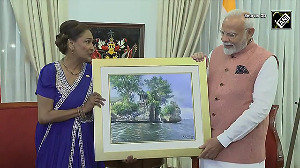He was the second employee in Nokia's mobile division, when few imagined Indian telecom would do so well. From marketing manager in 1995 - after stints with Pepsico and Reckitt Benckiser - to managing director of Nokia India, Sanjeev Sharma has played a pivotal role in ensuring the Finish company's domination in the marketplace.
Sharma, who declined to shift to Singapore for a larger role in Nokia because he thought "India is where the action is" will bid the company adieu on June 30. He talks to Surajeet Das Gupta about what needs to be done to address the Indian market. Excerpts:
The next growth area for mobile operators is obviously the rural market. What are the challenges?
Clearly, the main potential is in the rural areas, since urban density of mobile phones is very high in cities like Delhi and Mumbai - over 40 per cent - while rural density is merely 2 per cent. The challenge is how do we do so cost-effectively since the conventional western model will not suffice.
The first challenge is to adapt the distribution channel to meet the rural challenge. Nokia, for instance, is working with operators to jointly address the market and share the cost. There is a need to develop credit, which is best developed by companies coming together to get critical mass.
The second challenge is to reduce the total cost of ownership. Today companies are looking at cell sites which won't require air-conditioning, stripped-down base stations and, of course, infrastructure sharing. Technologies like adaptive multiple rate can increase the capacity of the network by 30 to 40 per cent.
But what about giving handset subsidies, which is the global practice?
I don't think subsidy is the answer. The sanctity of a contract is much lower in India, enforceability of law is poor and consumer delinquency is much higher. It is not a viable model for Indian operators who work on wafer-thin margins.
What about reduction in handset costs?
Handset costs have already come down to as low as Rs 1,300 to Rs 1,400. Second-hand phones cost as little as Rs 300-400. The main issue in expanding the rural market is not handset cost but the monthly cost of staying mobile. A lot has been done in this regard by operators - one year ago the minimum cost of staying mobile was Rs 300, today it is down to Rs 30-40 a month.
But does that mean there is no scope for reducing handset costs?
Handset prices play a secondary role in market expansion. What we need is out-of-the-box thinking for the bottom-of-the-pyramid user. India has shown the way of innovative product development in detergents or shampoos through the introduction of sachet packs, for instance. Who knows whether a handset without a display will be acceptable or not in a country were a large population is illiterate. There are new technologies like the single chipset, which will also reduce costs.
Does manufacturing in India help in reducing cost?
The main reason for manufacturing is to be closer to the market. Nokia has language variants of its phones in India and it is much easier to service such diversity if your manufacturing hub is located in the country. There are benefits of freight and customs but those are minor. In China, we have a robust R&D, which developed the pen-based handset which makes it easier to input Chinese characters; it was a success.
India is preparing for the roll out of 3G. Do you see a large market for this in India?
3G in India will not be a high-end player, it will be used for more effective spectrum utilisation and a lot of focus will be on using 3G technology for voice. I expect 3G in India to be used for mass-market applications. This will require mass-market 3G handsets.
The Yankee report recently created a storm by saying that Indian operators were over-stating their subscriber numbers.
Because of various tariff plans and especially the lifetime offers, we are going through a transition phase and it is difficult for anyone to arrive at the exact numbers. It is difficult to make out when a subscriber is churning out - it is not fair to knock off a subscriber if he has not used the phone for a month. It will take time for the industry to get a grip of the exact churn.
The report had calculated handsets sold with new subscriber base and concluded that the over-estimation of the subscriber numbers was about 20 per cent.
It is difficult to estimate the total number of handsets sold since there are parallel imports and, of course, the grey market, which was 90 per cent of the handset market in 2002, and has settled at 20-25 per cent today. In fact, we don't know the size of the second-hand market at all.
What are you estimates of the size of the Indian market. What percentage of it would be using, say, handsets below Rs 3,000?
For new subscribers, about 80 per cent will come from this segment, but at the same time there is a healthy replacement market. India is not as price sensitive a market as many would have imagined, because more than 50 per cent of the handsets sold are colour handsets and 20 per cent are with cameras. As far as the replacement market is concerned, about 100 million subscribers are expected to change their phones in the next three years.
Why is it that GPRS and Edge phone services did not take off in India?
I think it is a question of inertia, operators should have given the service as default, which they didn't.
Are camera and music phones killer applications or just a fad?
Camera phones are meant to capture spontaneous action. Users are moving increasingly to shooting, storing and sharing pictures with others. As far as music is concerned, mobile phones are the way to go forward.
Earlier the problem was one of storage capacity but that has been resolved with phones like the Nokia N91, which has the capacity to store 3,000 songs. They are posing a serious threat to MP3 players; just for your information, Nokia is already the largest seller of MP3 players globally.





